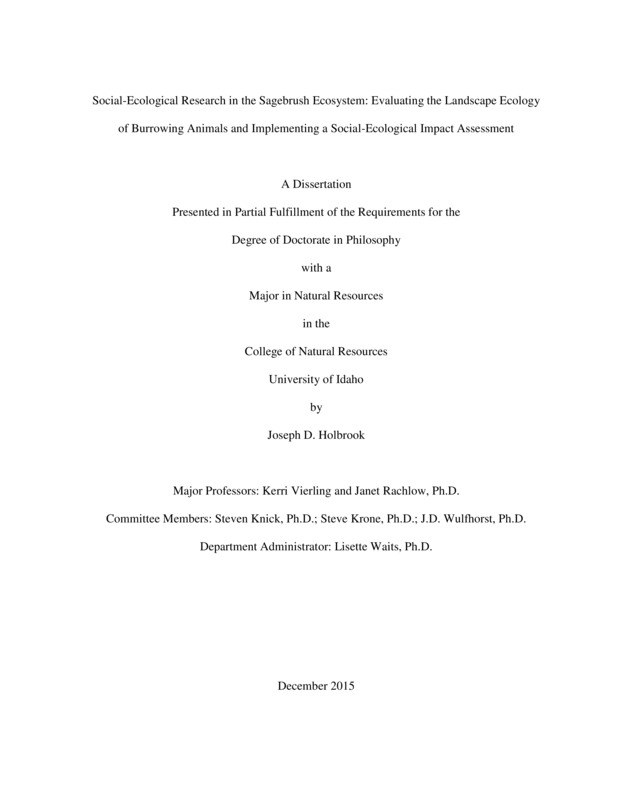Social-Ecological Research in the Sagebrush Ecosystem: Evaluating the Landscape Ecology of Burrowing Animals and Implementing a Social-Ecological Impact Assessment
Holbrook, Joseph D.. (2015). Social-Ecological Research in the Sagebrush Ecosystem: Evaluating the Landscape Ecology of Burrowing Animals and Implementing a Social-Ecological Impact Assessment. Theses and Dissertations Collection, University of Idaho Library Digital Collections. https://www.lib.uidaho.edu/digital/etd/items/holbrook_idaho_0089e_10732.html
- Title:
- Social-Ecological Research in the Sagebrush Ecosystem: Evaluating the Landscape Ecology of Burrowing Animals and Implementing a Social-Ecological Impact Assessment
- Author:
- Holbrook, Joseph D.
- Date:
- 2015
- Embargo Remove Date:
- 2016-12-15
- Keywords:
- Biological invasions Burrowing animals IGERT Sagebrush social-ecological systems Wildfire
- Program:
- Natural Resources
- Subject Category:
- Wildlife conservation; Sociology
- Abstract:
-
The goal of my research was to assist land management on public lands by advancing the understanding of how people interact with sagebrush landscapes, as well as assessing how ecological changes affect functionally important animals. I implemented a spatially extensive sampling design (see Chapter 1 for details) across Idaho and Oregon, USA, to evaluate how fire and biological invasions influence occupancy and abundance of harvester ants (Pogonomyrmex spp.), Piute ground squirrels (Urocitellus mollis), and American badgers (Taxidea taxus). Results suggest that occupancy of harvester ants was not influenced by biological invasions or fire, rather occupancy was positively driven by distribution of finer-textured soils and drier locals. Similarly, occupancy of ground squirrels was independent of fire and biological invasions, but positively associated with long-term precipitation, dispersal potential, and fine-textured soil. Density of harvester ants was positively affected by exotic annual and native perennial grasses, as well as fire. However, relative abundance of ground squirrels was positively associated with fine-textured soil, but negatively associated with cheatgrass (Bromus tectorum), fire frequency, human disturbance, and shrub cover. Badger occupancy was positively associated with ground squirrel occupancy and human disturbance (e.g., irrigated agriculture). These results suggest that the effect of fire and biological invasions are differentially influencing burrowing animals, with some winners (i.e., harvester ants) and losers (i.e., ground squirrels). Management actions targeted at restoring burrowing animals will need to be species- and parameter-specific (e.g., occupancy or abundance), and may or may not be associated with the large changes occurring in sagebrush systems.
Finally, I (and my research team) partnered with the U.S. Bureau of Land Management (BLM) and designed and implemented a social-ecological impact assessment associated with a project targeting juniper (Juniperus occidentialis) tree removal for sage-grouse (Centrocircus urophasianus) conservation in Owyhee County, Idaho. Through questionnaires, deliberative workshops, and participatory GIS, we identified a range of values and place meanings for many stakeholders from different backgrounds. These results provided clear mitigation opportunities for the BLM to address social concerns surrounding a management project on public lands. Our social-ecological approach and process could be easily transferred to other proposed projects on public lands throughout the U.S.
- Description:
- doctoral, Ph.D., Natural Resources -- University of Idaho - College of Graduate Studies, 2015
- Major Professor:
- Vierling, Kerri; Rachlow, Janet
- Committee:
- Knick, Steven; Krone, Steve; Wulfhorst, J.D.
- Defense Date:
- 2015
- Identifier:
- Holbrook_idaho_0089E_10732
- Type:
- Text
- Format Original:
- Format:
- application/pdf
- Rights:
- In Copyright - Educational Use Permitted. For more information, please contact University of Idaho Library Special Collections and Archives Department at libspec@uidaho.edu.
- Standardized Rights:
- http://rightsstatements.org/vocab/InC-EDU/1.0/

